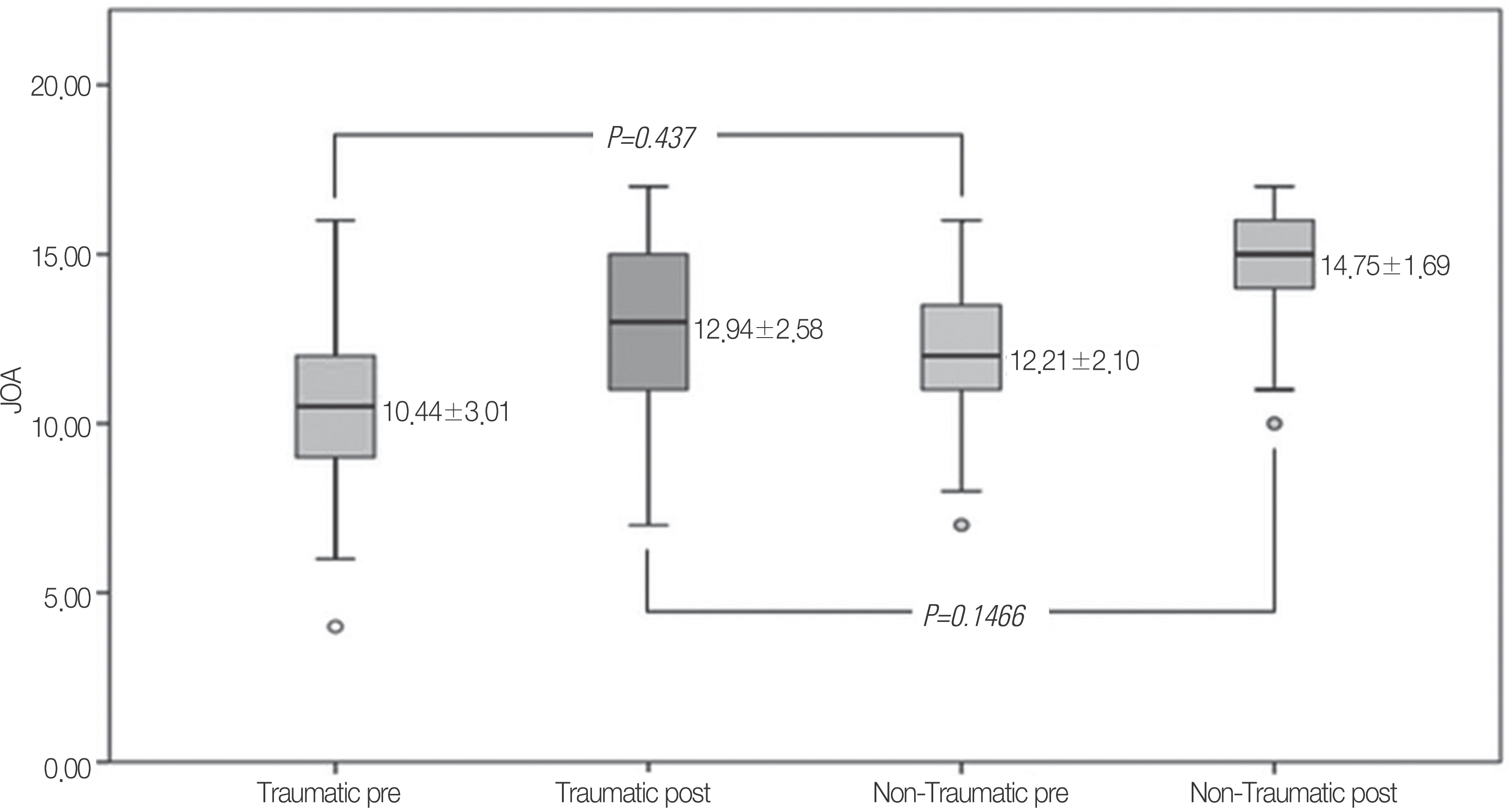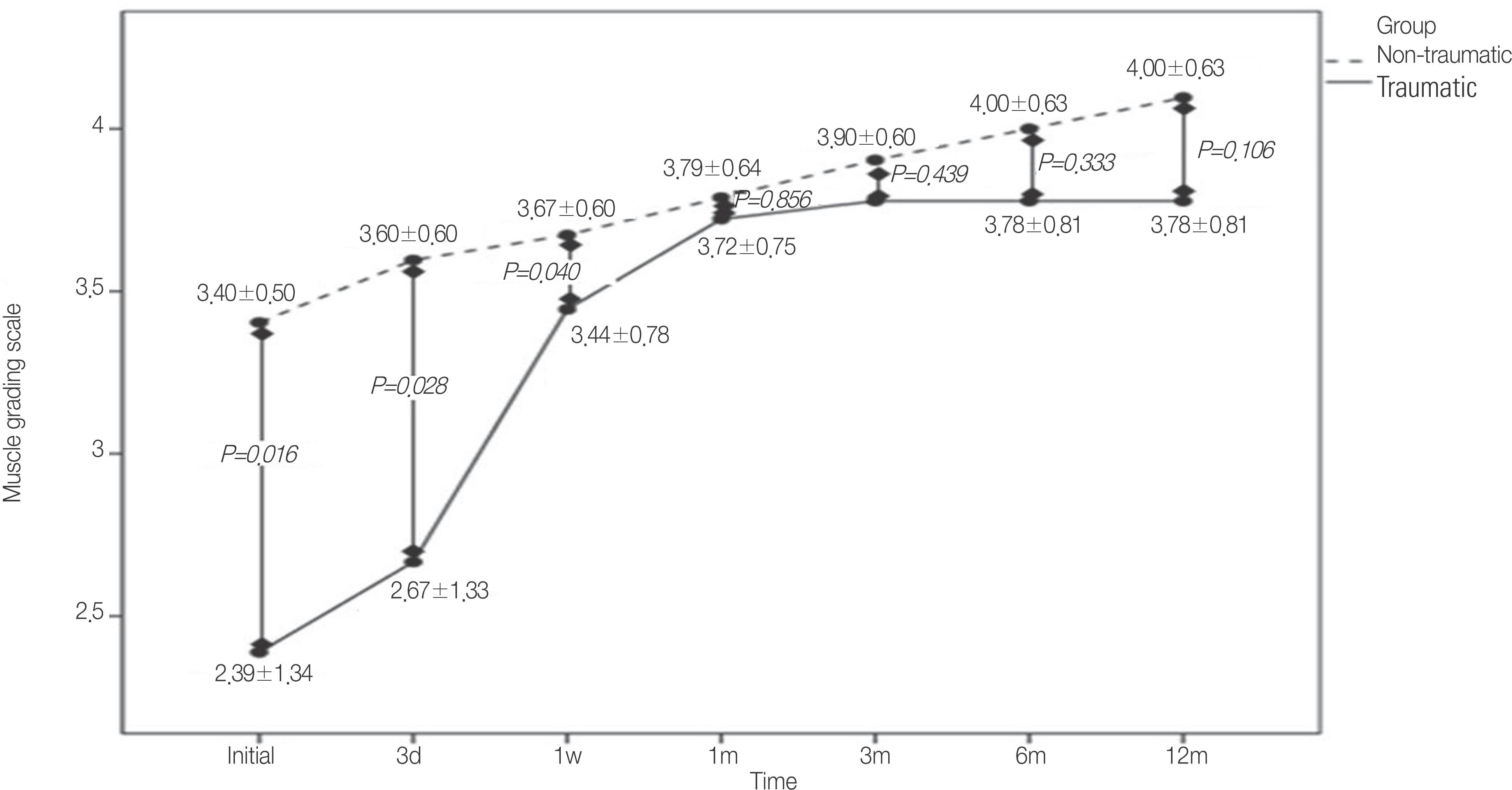J Korean Soc Spine Surg.
2015 Dec;22(4):133-139. 10.4184/jkss.2015.22.4.133.
The Relationship of Minor Trauma with the Surgical Outcome in Patients with Cervical Myelopathy
- Affiliations
-
- 1Department of Orthopedic Surgery, College of Medicine, Dong A University, Korea. gylee@dau.ac.kr
- KMID: 2150539
- DOI: http://doi.org/10.4184/jkss.2015.22.4.133
Abstract
- STUDY DESIGN: Retrospective study.
OBJECTIVES
To determine the influence of trauma on the neurologic course in patients who have undergone surgery for cervical myelopathy. SUMMARY OF LITERATURE REVIEW: The postsurgical outcomes were worse from trauma in patients who had a cervical ossification of the posterior longitudinal ligament (OPLL) or cervical canal stenosis, in comparison with patients who did not.
MATERIALS AND METHODS
The study was conducted on 70 patients who had undergone surgery due to cervical myelopathy from January 2004 to December 2013 and had at least 1 year of follow-up. Depending on trauma history, the patients were divided into two groups, and their radiological (simple radiographic, computed tomographic, and magnetic resonance imaging) and clinical (Japanese Orthopaedic Association [JOA] score, motor power of upper extremities) results were compared retrospectively.
RESULTS
Among 70 patients in total, 18 patients were in the trauma group and 52 were in the non-trauma group, and all cases in the trauma group had a history of minor trauma (11 cases of drivers traffic accidents, 4 cases of slipping and falling, 2 cases of minor pedestrian accidents, and 1 case of falling). Radiologically narrower diameter of the spinal canal showed statistically significant difference between two groups (p=0.042). The JOA scores before and after surgery and the recovery rate did not have a clinically meaningful difference with trauma. However, the degree of motor improvement was significantly higher for the trauma group within 1 week after surgery (p=0.040).
CONCLUSIONS
Minor trauma itself may adversely affect the patients' clinical courses.
Keyword
MeSH Terms
Figure
Reference
-
1. Epstein N. Ossification of the cervical posterior longitudinal ligament: a review. Neurosurg Focus. 2002; 13:ECP1.
Article2. Epstein N. Laminectomy for cervical myelopathy. Spinal Cord. 2003; 41:317–27.
Article3. Chi�uda H, Seichi A, Ta�eshita �, et al. Acute cervical spinal cord injury complicated by preexisting ossification of the posterior longitudinal ligament: a multicenter study. Spine (Phila Pa 1976). 2011; 36:1453–8.4. Braughler JM, Duncan LA, Chase RL. Interaction of lipid peroxidation and calcium in the pathogenesis of neuronal injury. Cent Nerv Syst Trauma. 1985; 2:269–83.
Article5. Hall ED, Braughler JM. Central nervous system trauma and stro�e. I. Biochemical considerations for oxygen radical formation and lipid peroxidation. II. Physiological and phar-macological evidence for involvement of oxygen radicals and lipid peroxidation. Free Radic Biol Med. 1989; 6:289–313.6. Rozario RA, Levine H, Stein BM. Cervical myelopathy and radiculopathy secondary to ossification of the posterior longitudinal ligament. Surg Neurol. 1978; 10:17–20.7. Wenger M, Adam PJ, Alarcon F, et al. Traumatic cervical instability associated with cord oedema and temporary quadriparesis. Spinal Cord. 2003; 41:521–6.
Article8. �oyanagi I, Iwasa�i Y, Hida �, et al. Acute cervical cord injury without fracture or dislocation of the spinal column. J Neurosurgery. 2000; 93:15–20.9. Tewari M�, Gifti DS, Singh P, et al. Diagnosis and prog- nostication of adult spinal cord injury without radiographic abnormality using magnetic resonance imaging: analysis of 40 patients. Surg Neurol. 2005; 63:204–9.10. Harrop JS, Sharan A, Ratliff J. Central cord injury: pathophysiology, management, and outcomes. Spine J. 2006; 6(Suppl):198–206.
Article11. Shimada �, To�io�a T. Sequential MRI studies in patients with cervical cord injury but without bony injury. Paraplegia. 1995; 33:573–8.
Article12. Ta�ahashi M, Harada Y, Inoue H, et al. Traumatic cervical cord injury at C3–4 without radiographic abnormalities: correlation of magnetic resonance findings with clinical feature and outcome. J Orthop Surg (Hong �ong). 2002; 10:129–35.13. �atoh S, I�ata T, Hirai N, O�ada Y, Na�auchi �. Influence of minor trauma to the nec� on the neurological outcome in patients with ossification of the posterior longitudinal ligament (OPLL) of the cervical spine. Paraplegia. 1995; 33:573–8.14. Fujimura Y, Na�amura M, Toyama Y. Influence of minor trauma on surgical results in patients with cervical OPLL. J Spinal Disord. 1998; 11:16–20.
Article15. �im YS, Chin D�, Cho YE, et al. Surgical treatment for ossification of the posterior longitudinal ligament of the cervical spine. J �orean Neurosurg Soc. 1997; 26:1237–45.16. Ta�ao T, Morishita Y, O�ada S, et al. Clinical relationship between cervical spinal canal stenosis and traumatic cervical spinal cord injury without major fracture or dislocation. Eur Spine J. 2013; 22:2228–31.
Article17. Morishita Y, Naito M, Wang JC. Cervical spinal canal stenosis: the differences between stenosis at the lower cervical and multiple segment levels. Int Orthop. 2011; 35:1517–22.
Article18. Morishita Y, Naito M, Hymanson H, et al. The relationship between the cervical spinal canal diameter and the pathological changes in the cervical spine. Eur Spine J. 2009; 18:877–83.
Article19. Edward WC, LaRocca H. The developmental segmental sagittal diameter of the cervical spinal canal in patients with cervical spondylosis. Spine (Phila Pa 1976). 1983; 8:20–7.20. Gore DR. Roentgenographic findings in the cervical spine in asymptomatic persons: a ten-year followup. Spine (Phila Pa 1976). 2001; 26:2463–6.21. Anderson � D. Targeting recovery: priorities of the spinal cord-injured population. J Neurotrauma. 2004; 21:1371–83.22. Snoe� GJ, IJzerman MJ, Hermens HJ, et al. Survey of the needs of patients with spinal cord injury: impact and prior-ity for improvement in hand function in tetraplegics. Spinal Cord. 2004; 42:526–32.
Article
- Full Text Links
- Actions
-
Cited
- CITED
-
- Close
- Share
- Similar articles
-
- Does Intramedullary Signal Intensity on MRI Affect the Surgical Outcomes of Patients with Ossification of Posterior Longitudinal Ligament?
- Progressive Quadriparesis following a Minor Trauma in a Patient with Klippel-Feil Syndrome: Case Report
- Degenerative Cervical Myelopathy: Pathophysiology and Current Treatment Strategies
- Clinical Features and Surgical Results of Cervical Myelopathy Caused by Soft Disc Herniation
- Guillain-Barre Syndrome Combined with Acute Cervical Myelopathy



